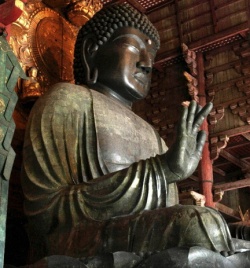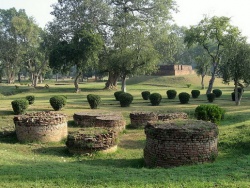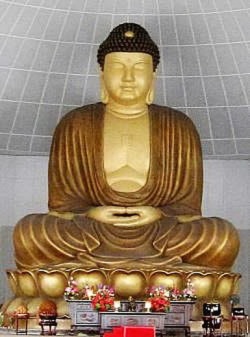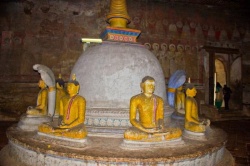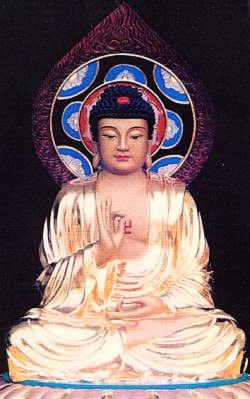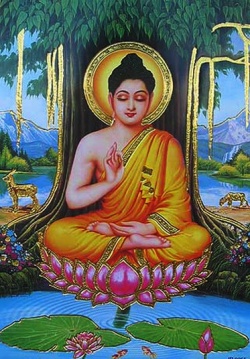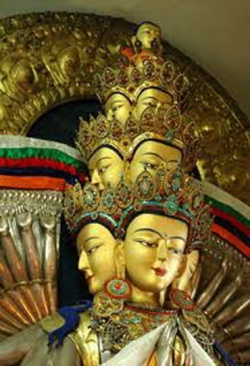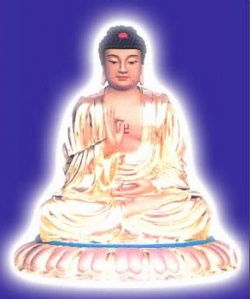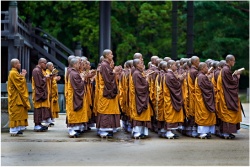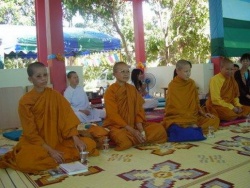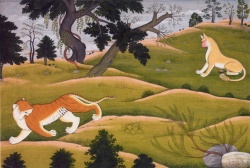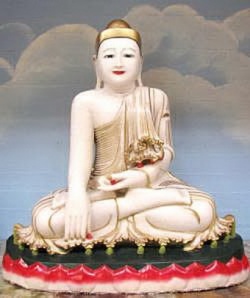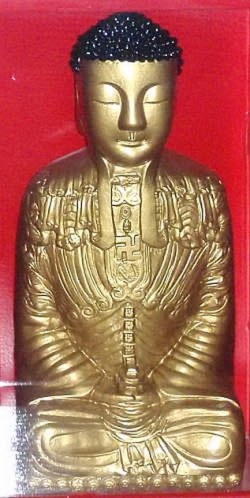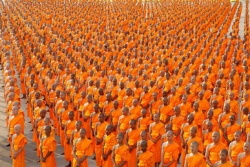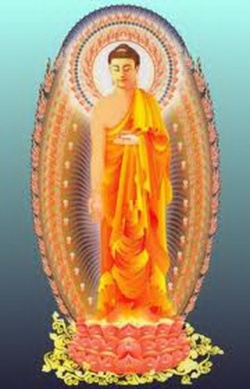Buddhist Sites in Afghanistan and Central Asia
The spread of Buddhism beyond the Indian subcontinent accelerated under the Mauryan king Aśoka (r. 265–238 BCE). An active proponent of Buddhism, he sent out religious missions.
BUDDHISM
iv. BUDDHIST SITES IN AFGHANISTAN AND CENTRAL ASIA
The spread of Buddhism beyond the Indian subcontinent accelerated under the Mauryan king Aśoka (r. 265–238 BCE; see BUDDHISM i). An active proponent of Buddhism, he sent out religious missions and stated some of the Buddhist principles in inscriptions. In his Edict XIII he wrote that he had dispatched missionaries to other peoples, in particular to the Kambojas, an Iranian people, and to the Yonas, that is, the Greeks (see AŠOKA and INDIA ii). This is confirmed by the finds in southern Afghanistan, in the vicinity of modern Laḡmān, of three Aramaic inscriptions of Aśoka; Greek, Aramaic, and bilingual Greek-Aramaic texts were found in Kandahar. This shows that Buddhism appeared in Afghanistan as early as the mid-3rd century BCE. According to the Pali Mahāvaṃsa chronicle, Buddhist monks from the countries of Pallavabhogga and Alasandra arrived at the court of King Duṭṭhagāmani (r. 101-77 BCE) to take part in a Buddhist festival (Mahāvaṃsa 29.38-39). Alasandra was probably Alexandria in the Caucasus, in the region of modern Kabul, while Pallavabhogga lay on the eastern frontier of Parthia—in Margiana or a Parthian subject state in Afghanistan (Litvinsky, 1967, pp. 88-91 with bibliography). Evidence provided by the Greek philosopher, geographer, and historian Alexander Polyhistor (105-35 BCE) about the Samanioi (Sk. šramana) Bactrians shows that, as early as the 1st century BCE, Buddhism was already widespread in Bactria (Lévi, 1891, p. 36; Asmussen 1965, p. 135). Later it penetrated other Central Asian regions, reached Xinjiang from Central Asia and Kashmir, and continued moving eastward. A Buddhist preacher, An Shih-kao, who came from one of the Parthian possessions (probably Margiana), reached China in 148 CE and began translating Buddhist books into Chinese. We know about several generations of translators who reached China from the west; they included Yüeh-chi (that is, Bactrians), Sogdians, and Parthians. Buddhism came very early (according to a legend, during Aśoka’s life) to southern Xinjiang, in particular to Khotan, whose inhabitants used the Iranian Khotanese language. The date for the arrival of Buddhism there is given by a Tibetan chronicle as 84 BCE and appears probable (Emmerick, 1967, p. 23; Litvinsky, 1999, pp. 37-38). A 1st-2nd-century CE manuscript of the Buddhist canonical text, the Dharmapada, was found in Khotan, and so it is likely that other canonical works would have been in circulation there in that period (Brough, p. 24).
It also follows that Buddhism must have arrived early in some other eastern Iranian areas besides Khotan, such as Nagarahāra, Arachosia, Kapiśa, Bactria, Parthia, and Sogdiana (see BUDDHISM i. and iii.). Of the numerous Buddhist ruins in these regions, the earliest are dated to the Kushan dynasty (1st-3rd centuries). Buddhist tradition describes Kaniṣka (r. 1st century CE), the most famous Kushan ruler, as a zealous Buddhist who took an active part in religious activities and built numerous Buddhist religious structures. His coinage carries images of Iranian and Hellenistic-Roman deities and—rarely—the Buddha. The Rabāṭak inscription made in Kaniṣka’s name (Sims-Williams and Cribb, pp. 77-79, 107-9) says nothing about the Buddha or Buddhist deities when dealing with his religious convictions.
In the 1st century BCE-1st century CE, Buddhism became an iconic religion (see Gandhāran art), and one of the earliest representations of the anthropomorphic Buddha is found on a gold token or temple coin from the Tillya-Tepe necropolis in Bactria (Fussman, 1987, pp. 71-72). Buddhist Gandhāran art spread not only to Afghanistan but also to the south of Central Asia and Xinjiang and created several schools across this vast territory. Gandhāran art, in individual works and cycles of works, functioned as an organic part of Buddhist constructions. These were, especially, vihāras (Buddhist monasteries), caityas (sacred places or objects), and stūpas (Buddhist commemorative monuments housing sacred relics of the Buddha or other saintly persons); their chief architectural and compositional ideas had originated in India, but then were adjusted to local climates, construction materials, and traditions of building and architecture. Each main type of Buddhist cultic building underwent a long evolution. In addition to freestanding Buddhist temples, etc., cave monasteries (likewise originally found in India) also became a local feature in Afghanistan, southern Central Asia, Xinjiang, and northern China.
Haḍḍa (ancient Nagarāhāra), near modern Jalālābād, was the site of one of the largest Buddhist centers in Afghanistan, and as such was visited and described by the Chinese pilgrims (such as Fa-hsien [ca. 337-ca. 422] and Hsüan-tsang [602-64]). There an area of about 15 km² remains covered with traces of numerous monasteries (Bāgh Gai, Deh Ghundi, Tepe Kāfirihā, Tepe Kalān, Tepe Shutur, Gan Nao, and others), large and small stūpas, sanctuaries, and artificial caves. The monasteries had square or rectangular courts surrounded by sanctuaries, cells, community halls, and other buildings. The center was occupied by a large stūpa and several small ones. Sometimes there were two courts, one lined with cells, the other with small sanctuaries. Next to the monasteries and between them there were numerous stūpas, caityas, and sculptures. The stūpas (there were over 500 of them) stood on multi-tier foundations with rich stucco or (rarely) stone decorative relief, architectural details including cornices, Corinthian columns, arches, etc., and rows of sculptural figures (sitting and standing Buddhas, other Buddhist and secular personages). The vihāras were similarly decorated. The art of Haḍḍa constitutes a special school of Gandhāran art, more free, more expressive and realistic than the art of the Gandhāra region. The sculptors more fully demonstrated their talent when presenting secular personages—being relatively free of canonic requirements in these cases—rather than deities; and the sculptured heads and figures are extraordinary beautiful (see Barthoux, 1930 and 1933; Mustamindi and Mustamindi, 1969; Rowland, 1971, pp. 27-33; Tarzi, 1976).
There were other Buddhist centers in Nagarāhāra; at one of them, Bimārān, a gold reliquary with the earliest anthropomorphic representations of Buddha was found (see MASSON). In the Kabul-Kapiśa area, a series of monasteries with stūpas flourished in the 1st-3rd centuries CE and were decorated with sculptures analogous to those of Haḍḍa (sites include Šotorak, Qalʿa-ye Nāder, Top Dara, and Paitāva; see ; Hackin, 1933; Meunié, 1942 and 1959, pp. 115-27).
Also supporting the early date of Buddhism in Bactria is a ceramic reliquary from the Kunduz area; it carries a kharoṣṭhī inscription which says that there was a Buddhist vihāra in the vicinity and that the teaching of the Dharmaguptaka sect was widespread there. The inscription is dated to the 1st-2nd centuries CE (Fussman, 1974, pp. 58-61). A “Buddhist platform” at Sorḵ Kotal, dated, together with the statues, to the 2nd-3rd century CE, is an outstanding monument (Schlumberger, Le Berre, and Fussman, 1983, pp. 75-81). The foundation of a Buddhist monastery at Kunduz can be probably dated to the end of the Kushan period (Hackin, 1959, pp. 19-22). Additional Buddhist temples are found in Dilberjin, Haibak, and other places.
Systematic archeological research in northern Bactria (that is, north of the Amu Darya, in the south of modern Uzbekistan and Tajikistan) has revealed numerous Buddhist monuments, mainly concentrated at Termez. In the northwestern part of Termez proper, not far from the Amu Darya, there was a large Buddhist center with a cave monastery, Kara Tepe (Karā Tappe) and an adjacent freestanding monastery Fayaz Tepe (Fayyāż Tappe). The Kara Tepe monastery covered about 7 ha and consisted of a series of adjacent complexes dating from different periods. Many of them had an above-ground section as well as an underground. The underground part contained in the center a massive stone pillar (or two pillars), surrounded by a corridor and frequently with an inner chamber. In front of the platform at the entrance to the underground part, there was a surface construction in the form of a square court with colonnade, a stūpa, a water tank, and pedestals and niches for sculptures. There were also complexes with different plans, and some two-tiered constructions. Numerous artistic objects were found at Kara Tepe (stone and stucco sculptures, paintings), and stone architectural details. Over 150 Indian inscriptions in kharoṣṭhī and brāhmī scripts were recovered. Construction started in the 1st-2nd centuries CE, and the complex reached its peak in the 3rd-4th centuries before declining in the 5th-6th (Staviskiǐ, pp. 23-24).
The Fayaz Tepe monastery, 1 km away from Kara Tepe, consists of three adjacent parts with courts and surrounding rooms. There is a large chamber in the central section with walls covered by splendid polychrome paintings of figures of Buddhist personages, clay and stucco sculptures, and a Buddhist stone relief. Thirty-five Indian inscriptions were also found there. Outside the chamber was a stūpa, initially round, later reconstructed. The coins found at the site date it to the 1st century CE. Some of the art (the wall paintings) was added later, in the 3rd, or probably 4th, century (Al’baum, pp. 18-27).
A Buddhist complex was also found in Ayrtam on the Amu Darya, west of Termez. There was found a decorative limestone frieze attributed to the Kushan period, depicting male and female musicians ornately dressed and garlanded, with drum, lute, and harp—a spectacular evidence of Gandhāran art spreading to Bactria. The Buddhist chapel and a stūpa at Zar Tepe (25 km from Termez) should also be mentioned. A town now known as Dalverzin Tepe on the border between the Surkhan (Sorḵān) and Hissar (Heṣār) valleys in Uzbekistan was another large Buddhist center; sanctuaries are found both inside and outside the town. In the place where the Kafirnigan River flows into the Amu Darya there was a Buddhist monastery of Kushan times called Uštur-mullo. Its stūpa was faced (as at Ayrtam) with stone slabs carrying reliefs; inside, the monastery was decorated with paintings. Finally, there were also Buddhist constructions in the city of Marv in the late Parthian period (1st-2nd centuries CE).
As was noted above, Buddhism reached Khotan at an early stage as well. What remains of Buddhist constructions can be seen in several places of the southern oases of Xinjiang, the easternmost of them being Mirān. A large Buddhist center existed there with about two dozen sanctuaries and monasteries scattered over an area of 4 x 5 km². Parts of them are well-preserved, especially rectangular, domed sanctuaries with round rooms inside with round stūpas. The constructions were decorated with paintings, sculptures, and reliefs. The paintings are clearly of the Gandhāran type, although there is an opinion that they were executed by the same masters who made sculptures for the Buddhist constructions of Swāt (Pakistan). The earliest constructions and the paintings at Mirān are dated to the 3rd century C.E. (Stein, I, pp. 456-543). The Buddhist sanctuary in Karadong is a contemporary or even earlier structure (mid-3rd century CE) with splendid Buddhist paintings that display Greek features and have a similarity to Gandhāran art (Keriya, pp. 82-105). “During the first through the third centuries C.E., the Buddhist Church was undergoing fundamental changes in the theological concepts and social bases” (Rosenfield, 1967, p. 220). Precisely at that time the Mahāyana school of Buddhism developed, although the Hīnayāna school preserved its positions in many areas. These religious processes, common to Buddhism everywhere, were also typical of Nagarāhāra, Kapiśa, Bactria, Khotan and the neighboring regions. There is information that people of Bactrian-Tokhari background worked actively on theological problems—such as the Buddhist theologian Ghoṣaka, who was born and worked in Tokharistan. He represented the Vaibhāṣika school that was connected with Tokharistan and was a branch of the Sarvāstivāda school, which was widely accepted in Afghanistan and Central Asia, including Khotan. It belonged to the Hīnayāna, yet some of the elements of the Sarvāstivāda doctrine were connected with Mahāyāna (Bailey, pp. 400-3; Bagchi, pp. 32-33; Litvinsky, 1968, p. 9).
Several Hīnayāna schools or sects were represented in Afghanistan: Mahāsāṃghika, Sarvāstivādin, Dharmaguptaka, and others (Konow, pp. 265 ;ff.; Fussman, p. 61). Epigraphic materials from northern Bactria directly refer to the Mahāsāṃghika school. Toward the end of the Kushan period there appeared proponents of the Sāṃmatiya school as well as, according to certain authors, of the Sarvāstivādin school (Vertogradova, 1995, pp. 41-43). There was no rigid dividing line between these schools and the Mahāyana school; their contemporaries looked at the proponents of Mahāsāṃghika, Sarvāstivādin, and Dharmaguptaka as Hīnayāna followers, yet they also promoted Mahāyāna (Bareau, pp. 303-5). Theological distinctions apart, not infrequently followers of Hīnayāna and Mahāyāna lived and studied in the same monasteries.
Buddhism first penetrated the southern Xinjiang oases, Khotan in particular, in the form of Hīnayāna (especially the schools of Sarvāstivāda and Mahāsāṃghika). In the 3rd century CE, Khotan became known as a Mahāyāna center. There a Chinese Mahāyānist discovered, soon after 260, a complete Sanskrit text of Prajñā-pāramitā-sutra. Later the role of Mahāyāna in Khotan became even greater (Litvinsky, 1999, pp. 37-41).
After the Kushans, Buddhism developed intensively in the provinces of Afghanistan, including the Iranian-populated areas. One of the best-known monuments of this period of Sasanian and Hephthalite domination (3rd-6th centsuries) was the Buddhist center in Bāmiān, where the Sasanian artistic influences that appear in Buddhist art are especially notable. The valley of Bāmiān is 250 km west of Kabul; at its northern boundary, at the foot of the Kuh-e Bābā range, a cliff face about 1,800 m long was honeycombed by the monks with some 750 artificial caves. The caves had intricate architectural designs and magnificent Buddhist wall paintings; only two contained stūpas. Also built into the cliff were two standing Buddhas, 38 and 53 m high, in huge niches excavated in the soft rock; these were completely destroyed by the Taliban regime in March 2001. Initially there were six figures: three colossi and three smaller statues. A “reclining” Buddha, showing him in the moment of “extinction” or “blowing-out” (parinirvāna), that is, his demise, was several times larger than the standing Buddhas (Hsüan-tsang et al.,, pp. 50-51). The cores of the standing figures were hewn in the rock, then overlaid with several layers of stucco, in which the body and robes were modeled. The hands were sculpted over wooden armatures and attached with wooden dowels. The two giant niches, like the other, smaller ones in the cliff, were decorated with paintings. The sculptures too were polychrome; initially they were gilded and encrusted with precious stones. There are remnants of a stūpa next to the cliff.
All the caves were small. Many of then were completely covered with Buddhist paintings, and there was at least one Buddhist statue in them, perhaps more. None of the caves could have been a vihāra; few of them could be used as meeting-rooms for the community of monks (sangha); there are no traces of permanent residence. It seems that the monks lived in the vihāra at the foot of the cliff (mentioned by the famous Chinese Buddhist traveler, scholar, and translator Hsüan-tsang), while the caves were mainly used for ritual worship or meditation. Opinions about the dates differ: the colossi probably date to the 6th century, and the monastic complex to the 7th and 8th centuries (Godard et al.; Hackin and Carl; Tarzi, 1977; Klimburg-Salter).
About 4 km from Bāmiān, the tributary Fulādi valley contains over fifty artificial caves that preserved Buddhist paintings (later than those of Bāmiān) on their walls and ceilings. In another tributary valley, Kakrāk, there is a standing Buddha, about 7 m high and about 100 artificial caves with wall paintings. Halfway between Bāmiān and Kabul, in the Ḡorband valley, in the area called Fundukistan (Fondoqestān), there is a Buddhist monastery. ;Its central court with a stūpa is surrounded with vaulted niches. Inside them were groups of magnificent statues, while the walls were covered with paintings. Benjamin Rowland described these works as showing a “formula of refined religious expression” while the entire composition “must have given the effect of a kind of a religious peep-show, in which, as on a stage, the visitor obtained a glimpse of celestial realms” (Rowland, 1971, pp. 45-46; for a description, see Hackin, Carl, and Meunié, pp. 49-58). Twenty km from Kabul, the Gul Dara monastery in the Kapiśa area was built in the 5th or 6th century; it has one courtyard, and the stūpas lie outside the monastery proper (Fussman and Le Berre).
Among the numerous other Buddhist monuments of Afghanistan dated to the 5th-8th centuries, Tepe Sardar (Tappe Sardār) at Ḡazni is notable. It is a monastery complex with a huge stūpa and numerous smaller ones, sanctuaries with paintings, reliefs, and sculptures, including a 15-m long reclining Buddha. There is also a Hindu shrine with sculptures (Taddei and Verardi, pp. 33-136).
Buddhism retained its positions in northern Afghanistan and in the south of Uzbekistan and Tajikistan, at the time of the Arab conquest called Tokharistan (Toḵārestān), not Bactria or (Mid. Pers.) Baxl. Several Buddhist constructions were discovered in its southern (Afghan) part (see, e.g., Hackin, Carl, and Meunié, pp. 19-22; Foucher, pp. 123-29), such as Taḵt-e Rostam near Balḵ—a site with ruins of an early medieval Buddhist monastery—and Tappe Rostam with a stūpa. According to Hsüan-tsang, in the first quarter of the 7th century there were about 100 Buddhist monasteries and about 3,000 monks in Balḵ, the capital of Tokharistan. A new monastery (Novasanghārāma) with gilded statues and halls encrusted with precious stones was built not far from the city. Known in Arabic and Persian sources as Nawbahār, it was destroyed after the Arab conquest (Barthold, Turkestan³, p. 77; see also BARMAKIDS).
In his travel notes, Hsüan-tsang wrote under the year 628 that there were Buddhist monasteries also in northern Tokharistan; for example, in Ta-mi (the city now called Termez) there were about a dozen monasteries and about 1,000 monks. In 726, Huei-ch’ao, another Chinese Buddhist pilgrim, wrote about the Tokhari principality Ko-to-lo or Khuttal in modern southern Tajikistan: “The king, the nobles and the people worship the faithful in triratna [see above]; many monasteries and monks are followers of the Hinayāna school” (tr. Fuchs, pp. 452-53). In this territory in the eastern part of northern Tokharistan, Buddhist construction dating to the 7th-8th centuries were discovered. The Adjina Tepe monastery was studied completely; it belonged to the two-courtyard type with the main and smaller stūpas in the center of one of the yards enclosed with corridors; the latter were decorated with niches with sculptures of seated Buddhas and a 14-m-high figure of the reclining Buddha. The courtyard of the other part was encircled with monastic cells and other premises (Litvinsky and Zeimal’). Other sites included the Khisht Tepe monastery, the Kalai Kafirnigan and Kafyr Kala sanctuaries, and the stūpas of the second period of Uštur-mullo (Litvinsky, 1981, pp. 35-66; Litvinskiǐ and Solov’ev, pp. 21-22, 60-62, 78-80).
The city of Marv was another large Buddhist center that yielded Buddhist buildings and manuscripts (Pugachenkova and Usmanova, pp. 51-82). Buddhist structures were also found in Ferghana (see FARḠĀNA) and especially in Semirechie (Bulatova, pp. 52-77; Goryacheva and Peregudova, pp. 168-83). Buddhist monuments of the Islamic period were studied in Semirechie and Marv; in Sogd, according to written sources and archeological finds, Buddhism was not widespread.
Buddhism was extremely popular in Khotan. According to the Chinese Buddhist pilgrim Fa-hsien, in 401 all dwellers of Khotan were Buddhists. He wrote about 14 large and numerous small monasteries (Fa-hsien, p. 18). According to Tibetan sources in the 8th-9th centuries, there were several thousand large, medium, and small monasteries and sanctuaries, some of them in private houses (Thomas, ed. and tr., p. 105; Emmerick 1967, pp. 25-31). In the Khotan principality, archeologists (especially M. Aurel Stein) discovered and excavated several sanctuaries, stūpas, and monasteries of the 5th-8th centuries. These were decorated with wall paintings and sculptures—Rawak, Farhad-Beg Yaliaki, Dandān-öiliq, Khadalik, Balawaste, and others. These continued and developed the compositional ideas born in India and radically transformed them (as in Rawak; for a detailed survey and bibliography see Yaldiz, pp. 186-219; Rowland, 1974, pp. 121-39).
Religious doctrine was further developed in the post-Kushan period and is reflected in numerous works dated to this period. Hināyāna and numerous other schools (Bareau) still existed; according to Hsüan-tsang, in the 7th century followers of Hināyāna comprised nearly two-thirds of the Indian monks; the remaining one-third were Mahāyāna followers. Evolution and development of Buddhist theological thought were not limited to India proper—they also occurred in the Iranian-populated territories. In each region, Buddhism had specific features. In Afghanistan and Central Asia, it came into contact with other religions of the Iranians: Zoroastrianism, Manicheism, Christianity, Judaism, and Hinduism borrowed from India. This gave rise to various syncretistic beliefs, a process reflected in such religious centers as Tepe Sardār and in Zoroastrian and Sasanian influence on Buddhist iconography (Rowland, 1972, pp. 379-82). Certain Hināyāna schools (especially the Sārvāstivādin, Mahāsāṃghika, and Lokottaravādin) developed the ideas that promoted Mahāyāna doctrines (Bareau, pp. 290-382). There was no insurmountable wall between the two Buddhist trends; late in the 8th century, a Buddhist pilgrim had to admit that it was hard to identify some of the schools as belonging to Hināyāna or Mahāyāna (I-Tsing, pp. 13-15). In their descriptions of the states of Afghanistan and Central Asia (especially Kapiśa, Bāmiān, and Tokharistan) Hsüan-tsang (ca. 628-32) and later Huei-ch’ao (726) wrote that the rulers, nobility, and common people were all zealous Buddhists, and that at many monasteries the monks included scholars of Buddhist theology. Balkh was even known as “Little Rājagṛha,” after one of the holy Buddhist centers in India, the place where, according to tradition, the first Buddhist council took place after the death of Šakyamuni Buddha. Hināyāna was widespread in Tokharistan; according to Hsüan-tsang, Lokottaravādin, a Hināyāna school, was popular in Bāmiān; there were also preachers of the Mahāsāṃghika school there; and Huei-ch’ao reported about Mahāyāna and Hināyāna supporters. Hsüan-tsang wrote that in Kapiśa the majority followed the Mahāyāna school and that there were also learned monks of the Sarvāstivādin and Mahiśāsana schools. Later, Huei-ch’ao reported that the Hināyāna school predominated there (Hsüan-tsang et al., pp. 44, 49-45; Hui-li, pp. 49, 53-57; Fuchs, pp. 448-49). Fragments of 6th-8th-century manuscripts related to the Mahāsāṃghika and Sarvastivādin schools came to light in Bāmiān (Lévi, 1932, pp. 2-8). “These dates and sectarian identifications become particularly important when coupled with the fact that the manuscripts were written in scripts and languages from India, Khotan, and Kucha. These Central Asian religious centers were connected to Bamian by trade routes. Thus ... we can discern a parallel between the cultural and religious milieu of Bamian and intellectual climate of major Central Asian Buddhist centers in the sixth through eight centuries” (Klimburg-Salter, p. 58).
Manuscripts on birch bark were found in Tokharistan: a vinaya (one of the three divisions of the Buddhist scriptures) fragment from Zang Tepe and small fragments from Kafyr Kaly in brāhmī script (7th-8th centuries). A Sanskrit manuscript in brāhmī, of which 150 pages came down to us, was found in Bayram-Ali (at Marv). It was either a concise exposition of certain Buddhist works or a preacher’s notebook. The colophon indicates that the manuscript and its author belonged to the Sarvāstivādin school (Vorob’eva-Desyatovskaya, pp. 63-89).
At that time Khotan was the largest center of Iranian Buddhism (Emmerick, 1983, pp. 962-64) and possessed a considerable number of Buddhist Sanskrit works that had arrived from India; from Khotan these were passed on to China. Mahāyāna became more popular in Khotan than it was in Tokharistan; at the time of Hsüan-tsang its domination was uncontested, although there remained Hināyāna supporters. This domination became even more obvious in the 8th century (Fuchs, p. 457). A Tibetan chronicle of the 8th-9th century compares the number of Mahāyāna supporters with the number of hairs on a horse’s body and the number of Hināyāna supporters, with the number of hairs on its ear (Thomas, ed. and tr., p. 311). For a long time, the Khotanese learned Buddhism from Sanskrit works, Sanskrit being the liturgical language. It was approaching the 10th century when they created a Khotanese Buddhist literature that included translations of the major Sanskrit Buddhist works. Parts of some works reveal local interpretations of Buddhist doctrines. Original works also appeared (e.g., the Book of Zambasta); these were neither expositions of Sanskrit compositions nor translations (Emmerick, ed., 1968; 1977, pp. 65-74). The Buddhist doctrines these works contained reflected the religious situation in Khotan (Williams, pp. 114-15; for a detailed analysis of Khotanese Buddhism, see Litvinsky, 1999, pp. 38-54).
Many of the Sogdians who lived in Xinjiang, China, and Mongolia were Buddhists; settlements and even towns were populated by them. Buddhism for them was one of the major religions, in contrast to its standing in their homeland. Numerous Sogdian Buddhist manuscripts were discovered, the absolute majority of them being translations of Chinese Buddhist works of the Mahāyāna school dated to the 7th-10th century (see Utz, with detailed bibliography).
Buddhism thus played an important role in the history and culture of several Iranian peoples. It brought not only the Indian religion, but also philosophy, literature, and art within the Iranians’ reach. It served a bridge of sorts between them and Indian culture as a whole; and it intensified cultural exchange between Central Asia and India (Bagchi; Litvinskiǐ, 1996 and 1997).
Finally, the Buddhist heritage can be discerned among the Iranians in the Islamic epoch as well. In the early Islamic period, descendants of Buddhist religious figures filled high-ranking posts (see BARMAKIDS). There is an opinion that Buddhism greatly influenced the ideology and practice of early eastern Sufism. Madrasas, higher Islamic educational institutes, appeared in the 10th century precisely in Central Asia and were probably in some respects genetically connected with Buddhist monasteries. Since the 10th century New Persian poetry has preserved the word bot “Buddha”, meaning “idol, beauty, the beloved”; and other Buddhist traces can be found in the literature, art, and culture of the Iranians in the Muslim period (Litvinsky, 1968, pp. 66-67; Gimaret; Melikian-Chirvani; Scott).
See also buddhism ii. IN ISLAMIC TIMES; AFGHANISTAN viii and ix.
Bibliography:
Abbreviation. MDAFA—Mémoires de la Délégation Archéologique Française en Afghanistan.
L. I. Al’baum, “Zhivopis’ svyatilishcha Fayaz-tepe” (Paintings of the Fayyāż Tappe sanctuary), in Kul’tura Srednego Vostoka s drevneǐshikh vremen do nashikh dneǐ. Izobrazitel’noe i prikladnoe iskusstvo (Culture of the Middle East from the earliest times up to our days. Fine and applied arts), Tashkent, 1990, pp. 18-27.
J. P. Asmussen, Xuā̄tvānīft. Studies in Manichaeism, Copenhagen, 1965.
H. Bailey, “Indo-Iraniana (III, 5). Tarmita,” BSOAS 13/2 1950, pp. 400-3.
P. C. Bagchi, India and Central Asia, Calcutta, 1955.
A. Bareau, Les sectes bouddhiques de Petit Véhicule, Publication de l’École Française d’Extrême-orient 38, Saigon, 1955.
J. Barthoux, Les fouilles de Haḍḍa, III. Figures et figurines, MDAFA 6, Paris, 1930.
Idem, Les fouilles de Haḍḍa, I. Stupes et sites. Texte et dessins, MDAFA 4, Paris, 1933.
J. Brough, The Gandhāri Dharmapada, London et al., 1962.
V. A. Bulatova, Drevnyaya Kuva (Ancient Kuva), Tashkent, 1972.
C. Debaine-Francroft and A. Idriss, eds., Keriya, mémoires d’un fleuve. Archéologie et civilization des oasis du Taklamakan, Paris, 2001.
R. E. Emmerick, Tibetan Texts Concerning Khotan, London, 1967.
Idem, ed., The Book of Zambasta. A Khotanese Poem on Buddhism, London, 1968.
Idem, “Three ‘Monsters in Khotan’,” Stud. Ir. 6/1, 1977, pp. 65-74.
Idem, “Buddhism Among Iranian Peoples,” in Camb. Hist. Iran 3/2, 1983, pp. 949-64.
Fa-hsien, tr. Li Yung-hsi as A Record of the Buddhist Countries, Beijing, 1957.
A. Foucher, La vieille route de l’Inde, de Bactres a Taxila, 2 vols., MDAFA 1, Paris, 1942-47.
W. Fuchs, “Huei-ch’ao’s Pilgerreise durch Nordwest-Indien und Zentral-Asien um 726,” SPAW 30, 1938, pp. 426-57; repr. Berlin, 1939.
G. Fussman, “Documents épigraphiques Koushans,” Bulletin de l’École Française d’Extrême-Orient 61, 1974, pp. 1-66.
Idem, “Numismatic and Epigraphic Evidence for the Chronology of Early Gandharan Art,” in Investigating Indian Art. Proceedings of a Symposium on the Early Buddhist and Hindu Iconography held at the Museum of Indian Art, Berlin 1986, Berlin, 1987, pp. 89-104.
G. Fussman and M. Le Berre, Monuments bouddhiques de la région de Caboul I. Le monastère de Gul Dara, MDAFA 22, Paris, 1976.
D. Gimaret, “Bouddha et les bouddhistes dans la tradition musulmane,” JA 257/3-4, 1969, pp. 273-316.
A. Godard, Y. Godard, and J. Hackin, Les antiquités bouddhiques de Bamiyan, MDAFA 2, Paris, 1928.
V. D. Goryacheva and S. Ya. Peregudova, “Buddiǐskie pamyatniki Kirgizii” (Buddhist monuments of Kirghizia), VDI, 1996, no. 2. 168-83.
J. Hackin, L’oeuvre de la Délégation Archéologique Française en Afghanistan (1922-1932). Archéologie bouddhique, Tokyo, 1933.
Idem, “Fouilles de Kunduz (1936),” MDAFA 7, Paris, 1959, pp. 19-22.
Idem and J. Carl, Nouvelles recherches archéologiques a Bāmiyān, MDAFA 3, Paris, 1933.
J. Hackin, J. Carl, and J. Meunié, Diverses recherches archéologiques en Afghanistan (1933-1940), MDAFA 8, Paris, 1959.
Hsüan-tsang et al., Si-yu-ki; tr. S. Beal as Si-yu-ki. Buddhist Records on the Western World, London, 1884; repr. London, 2000.
Hui-li, The Life of Hsüan-tsang,the Tripitaka-Master of the Great Tzu En Monastery, Beijing, 1959.
I-Tsing, A Record of the Buddhist Religion as Practiced in India and in the Malay Archipelago (C.E. 671-695), tr. J. Takakusu, Oxford, 1996.
D. Klimburg-Salter, The Kingdom of Bāmiyān. Buddhist Art and Culture of the Hundu Kush, Naples and Rome, 1989.
S. Konow, Karoshthi Inscriptions with the Exception of those of Aśoka, Corpus Inscriptionum Indicarum, II/1, Calcutta, 1929.
S. Lévi, “Le bouddhisme et les Grecs,” RHR 23, 1891, pp. 36-49.
Idem, “Notes sur des manuscrits sanscrits provenant de Bâmiân (Afghanistan) et de Gilgit (Cachemire),” JA 224, 1932, pp. 1-21.
B. A. Litvinskiǐ [Litvinsky, Litvinskij], Outline History of Buddhism in Central Asia, Dushanbe, 1968.
Idem, “Kalai-Kafirnigan. Problems in the Religion and Art of the Medieval Tokharistan,” East and West 31/1-4, 1981, pp. 35-66.
Idem, “Indiǐskiǐ faktor v tsivilizatsii Tsentral’noǐ Azii” (The Indian factor in the civilization of Central Asia), in Aziya—dialog tsivilizatsiǐ, St. Petersburg, 1996, pp. 153-93.
Idem, “Buddizm i buddiǐskaya kul’tura Tsentral’noǐ Azii (drevnost’)” (Buddhism and the Buddhist culture of Central Asia [Antiquity]), in Moskovskoe vostokovedenie. Ocherki, issledovaniya, razrabotki, Moscow, 1997.
Idem, Die Geschichte des Buddhismus in Ostturkestan, Wiesbaden, 1999.
Idem, “Buddizm v Sredneǐ Azii (problemy izucheniya)” (Buddhism in Central Asia: Study problems), VDI 4, 2001.
B. A. Litvinskiǐ and T. I. Zeǐmal’, Adzhina-Tepa. Arkhitektura. Zhivopis’. Skul’ptura (Adjina-tepe. Architecture. Paintings. Sculpture), Moscow, 1971.
B. A. Litvinskij and V. S. Solovjev, Kafyrkala, frühmittelalterliche Stadt im Vachš-Tal, Süd-Tadžikistan, Materialien zur Allgemeinen und Vergleichenden Archäologie 28, Munich, 1985.
A. S. Melikian-Chirvani, “L’évocation litteraire du bouddhisme dans l’Iran musulman,” Le monde iranien et l’Islam 2, 1974, pp. 1-72.
J. Meunié, Shotorak, MDAFA 10, Paris, 1942.
Idem, Gol-i-Nader, une pétite fondation bouddhique au Kapisa, MDAFA 8, Paris, 1959, pp. 115-27.
Ch. Mustamindi and M. Mustamindi, “Nouvelles fouilles à Hadda (1966-67) par I’Institut Afghan d’ Archéologie,” Arts asiatiques 19, 1969, pp. 15-36.
G. A. Pugachenkova and Z. Usmanova, “Buddhist Monuments in Merv,” in In the Land of the Gryphons. Papers on Central Asian Archaeology in Antiquity, ed. A. Invernizzi, Florence, 1995, pp. 51-82.
J. M. Rosenfield, The Dynastic Arts of the Kushans, Berkeley and Los Angeles, 1967.
B. Rowland, Art in Afghanistan. Objects from the Kabul Museum, London, 1971.
Idem, “Iranian Elements in the Art of Afghanistan and Central Asia: the Formation of a Central Asian Style,” in The Memorial Volume of the VIth International Congress of Iranian Art and Archaeology II, Tehran, 1972, pp. 379-82.
Idem, The Art of Central Asia, New York, 1974.
D. Schlumberger, M. Le Berre, and G. Fussman, Surkh Kotal en Bactriane, MDAFA 25, Paris, 1983.
P. Schwartz, “Bemerkungen zu den arabischen Nachrichten über Balkh,” in Oriental Studies in Honour of Curetji ErachjiPavry, ed. Jal Dastur Curetji Pavry, London, 1933, pp. 434-43.
D. A. Scott, “The Iranian Face of Buddhism,” East and West 40/1-4, 1990, pp. 43-77.
N. Sims-Williams and J. Cribb, “A New Bactrian Inscription of Kanishka the Great,” Silk Road Art and Archaeology 4, 1995-96, pp. 75-142.
B. Ya. Staviskiǐ, Sud’by buddizma v Sredneǐ Azii po dannym arkheologii (The destinies of Buddhism in Central Asia according to archeological data), Moscow, 1998.
M. A. Stein, Serindia. Detailed Report of Explorations in Central Asia and Westernmost China Carried out and Described under the Orders of H.M. Indian Government, 5 vols. Oxford, 1921.
M. Taddei and G. Verardi, “Tapa Sardar: Second Preliminary Report,” East and West 28, 1978, pp. 33-136.
Z. Tarzi, “Hadda à la lumière des trois dernières campagnes de fouilles de Tapa-e-Shotor (1974-1976),” Comptes rendus de l’Académie des Inscriptions et Belles-lettres, 1976, pp. 381-410.
Idem, L’architecture et le décor rupestre des grottes de Bamiyan, 2 vols., Paris, 1977.
F. W. Thomas, ed. and tr., Tibetan Literary Texts and Documents Concerning Chinese Turkestan, Oriental Translation Fund N.S. 32, 4 vols., London, 1935-65.
D. A. Utz, A Survey of Buddhist Sogdian Studies, Bibliographia Philologica Buddhica, Series Minor 3, Tokyo, 1980.
V. V. Vertogradova, Indiǐskaya èpigrafika iz Kara-tepe v Starom Termeze. Problemy deshifrovki i interpretatsii (Indian epigraphic inscriptions from Kara Tepe in Old Termez. Problems regarding decipherment and interpretation), Moscow, 1995.
M. I. Vorob’eva-Desyatovskaya, “Pamyatniki pis’ma kharoshtkhi i brakhmi iz Sovetskoǐ Sredneǐ Azii” (Monuments of Kharoṣṭhī and Brāhmī inscriptions from Soviet Central Asia), in Istoriya i kul’tura Tsentral’noǐ Azii (History and culture of Central Asia), ed. G. M. Bongard-Levin, Moscow, 1983, pp. 22-96.
J. Williams. “The Iconography of Khotanese Painting,” East and West 23/1-2, 1973, pp. 109-54.
M. Yaldiz, Archäologie und Kunstgeschichte Chinesisch–Zentralasiens (Xinjiang), HO 7/3/2, Leiden, 1987.
(Boris A. Litvinsky)
